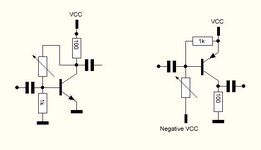neazoi
Advanced Member level 6
Hello,
I am trying to achieve the next:
Having an HF amplifier that can amplify incoming antenna signals, ONLY higher than a preset signal level. All signals below that preset level should be ignored.
I have achieved this behaviour with a class-C amplifier but this one works only on very high threshold of input signals, above 0.5V or so.
What I need, is a similar behaviour with the class-C amplifier but for much lower signal levels (those encountered on an antenna).
I am trying to achieve the next:
Having an HF amplifier that can amplify incoming antenna signals, ONLY higher than a preset signal level. All signals below that preset level should be ignored.
I have achieved this behaviour with a class-C amplifier but this one works only on very high threshold of input signals, above 0.5V or so.
What I need, is a similar behaviour with the class-C amplifier but for much lower signal levels (those encountered on an antenna).
